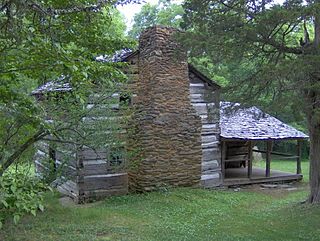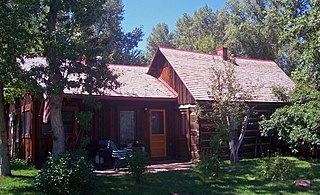
Francis Marion, also known as the Swamp Fox, was a military officer who served in the American Revolutionary War (1775–1783). Acting with the Continental Army and South Carolina militia commissions, he was a persistent adversary of the British in their occupation of South Carolina and Charleston in 1780 and 1781, even after the Continental Army was driven out of the state in the Battle of Camden. Though Marion never commanded a large army or led a major battle, his use of irregular methods of warfare makes him one of the fathers of modern guerrilla warfare and maneuver warfare, and he is noted as an ancestor of the U.S. Army Rangers and the 75th Ranger Regiment.
Francis Marion University is a public university near Florence, South Carolina. It is named in honor of American Revolutionary War Brigadier General Francis Marion.

Gascoigne Bluff is a bluff next to the Frederica River on the western side of the island of St. Simons, Georgia which was a Native American campground, the site of a Franciscan monastery named San Buenaventura, and the site of the Province of Georgia's first naval base.

Long Grass Plantation is a historic house and national historic district located along what was the Roanoke River basin. In the 1950s most of it was flooded and became the Buggs Island Lake/John H. Kerr Reservoir in Mecklenburg County, Virginia. The house was built circa 1800 by George Tarry on land belonging to his father, Samuel Tarry, and Long Grass Plantation encompassed approximately 2000 acres (8 km2).
A plantation house is the main house of a plantation, often a substantial farmhouse, which often serves as a symbol for the plantation as a whole. Plantation houses in the Southern United States and in other areas are known as quite grand and expensive architectural works today, though most were more utilitarian, working farmhouses.

Boone Hall Plantation is a historic district located in Mount Pleasant, Charleston County, South Carolina, United States and listed on the National Register of Historic Places. The most important historic structures in the district are the brick slave cabins located along Slave Street which date between 1790 and 1810. The plantation is one of America's oldest plantations still in operation. It has continually produced agricultural crops for over 320 years and is open for public tours.

Mount Airy, near Warsaw in Richmond County, Virginia, constructed in 1764 for Colonel John Tayloe II, perhaps the richest Virginia planter of his generation, is a mid-Georgian plantation house, the first built in the manner of a neo-Palladian villa. John Ariss is the attributed architect and builder. Tayloe's daughter, Rebecca and her husband Francis Lightfoot Lee, one of the only pair of brothers to sign the Declaration of Independence are buried on the estate, as are many other Tayloes. Before the American Civil War, Mount Airy was a prominent racing horse stud farm, as well as the headquarters of about 10-12 separate but interdependent forced-labor plantations along the Rappahannock River. Mount Airy is listed on the National Register of Historic Places as a National Historic Landmark as well as on the Virginia Landmarks Register and is still privately owned by Tayloe's descendants.
Snow's Island is an area of swampy lowlands along the Pee Dee River in Florence County, South Carolina. The area is historically significant as the headquarters during the American Revolutionary War for forces led by Francis Marion (1732-1795), a South Carolina militia officer who is celebrated as the "Swamp Fox." Employing guerrilla war tactics, Marion significantly contributed to the American war effort by conducting numerous raids on British outposts." The site was declared a National Historic Landmark in 1974.

Rehoboth Church is a historic log cabin-style Methodist church in the countryside of Monroe County, West Virginia, United States, 2 miles east of the town of Union. Listed on the National Register of Historic Places since 1974, it is renowned for being the oldest existing church building in West Virginia.

The Walker Sisters Place was a homestead in the Great Smoky Mountains of Sevier County, in the U.S. state of Tennessee. The surviving structures— which include the cabin, springhouse, and corn crib— were once part of a farm that belonged to the Walker Sisters— five spinster sisters who became local legends due to their adherence to traditional ways of living. The sisters inherited the farm from their father, and after the Great Smoky Mountains National Park was formed in the 1930s, they obtained a lifetime lease. The National Park Service gained control of the property in 1964 when the last Walker sister died. The surviving structures were placed on the National Register of Historic Places in 1976.

Maden Hall Farm, also called the Fermanagh-Ross Farm, is a historic farm near the U.S. city of Greeneville, Tennessee. Established in the 1820s, the farmstead consists of a farmhouse and six outbuildings situated on the remaining 17 acres (6.9 ha) of what was once a 300-acre (120 ha) antebellum farm. Maden Hall has been designated a century farm and has been placed on the National Register of Historic Places.
Gregg House may refer to:

A plantation complex in the Southern United States is the built environment that was common on agricultural plantations in the American South from the 17th into the 20th century. The complex included everything from the main residence down to the pens for livestock. Until the abolition of slavery, such plantations were generally self-sufficient settlements that relied on the forced labor of enslaved people.

The Matthew Callahan Log Cabin is located on South Third Street in Aspen, Colorado, United States. It was built in the early 1880s. In 1987 it was listed on the National Register of Historic Places along with a group of other historic properties in the city.

The Cedars is an historic early 19th century house in Columbus, Mississippi.

Rankin-Harwell House, also known as The Columns, Carolina Hall, and the James Harwell House, is a historic plantation house located near Florence, Florence County, South Carolina. It was built in 1857, and is a two-story, frame, Greek Revival style dwelling. It features 22 giant freestanding Doric order stuccoed brick columns that surround the house on three sides. It rests on a raised basement and has a low-pitched hipped roof.

Roseville Plantation is a historic home located near Florence, Florence County, South Carolina. It was built about 1885 and renovated about 1910. It is a two-story, lateral gabled, weatherboard-clad residence. The building consists partly of mortise and tenoned hand-hewn and peeled log construction. It was built on the foundations of the original plantation house built about 1835. The house at Roseville Plantation is at the end of a tree lined dirt driveway and set at the center of a broad sparsely landscaped lawn, resting upon a brick pier foundation which has recently been enclosed at its perimeter with stuccoed concrete block. It features a broad, one-story, hip roofed wraparound veranda.

Gregg-Wallace Farm Tenant House is a historic home located near Mars Bluff, Florence County, South Carolina. It was built about 1890, and is representative of a typical Mars Bluff vernacular tenant house for African Americans. Tenant houses often evolved from one-room slave houses, first by the addition of a shed room at the rear and a front porch, then by the addition of a second room.

The F.S. King Brothers Ranch Historical District is located in the hills northeast of Laramie, Wyoming.



















